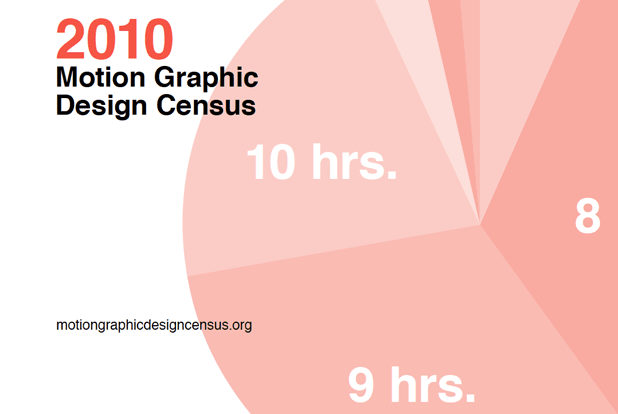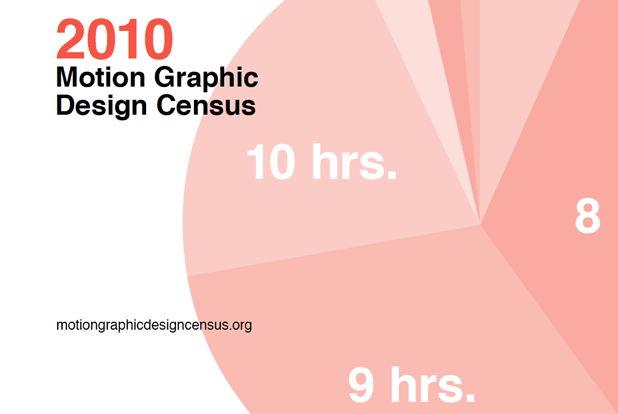
The unofficial, web-based Motion Graphics Design Census for 2010 is now available from their web site. It compiles over 5500 responses – distributed roughly evenly between the US and non-US – into a series of responses about age, software, and – primarily – income. Of course, it’s only a survey of those who responded rather than the industry as a whole. Also, not everyone responded to every question – for example, only 219 self-employed artists offered how much they charged per hour, and most of the charts are based just on US respondents. With those caveats, here’s what stuck out for us:
- After Effects is the most used application (surprise). Photoshop was second (okay, now we are surprised.)
- Maya and Cinema 4D have similar followings among 3D motion graphics users, with 3D Studio Max well behind; and Lightwave didn’t even register. (Again, this is a survey of respondents – not of everyone in the industry…)
- A surprisingly overwhelming majority of users who responded use Macs – far more than the conventional wisdom of even just a few years ago.
- 9 hours is an average workday for staff; half of self-employed artists consider 10 hours to be a “day.”
- Speaking of a day, roughly half of self-employed designers charge a day rate, while roughly a quarter charged by the hour and a quarter by the project.
- Over a third of the self-employed artists do work without a written agreement – or even an email trail. (Trust us: It’ll end in tears…)
- A third of self-employed artists who billed hourly charged $35/hour or less; $50 seems like an average rate; less than a quarter charge $75/hour or more. For those who charged by the day (keeping in mind three-quarters thought a “day” was longer than 8 hours), the sweet spot was $500-$600/day; over 80% of respondents charged $400-$750/day.
By comparison, over a decade ago we were told we were underbidding at $100/hour; our day rate was typically $800/day – and $1000 for special circumstances (long day, rush job, film when few others knew how to do it on the desktop). The 90s were indeed the salad days for freelance motion graphics artists; average rates have certainly come down since.
- Talking strictly what we assume to be gross salary, on average the self-employed make a bit more than staff – especially animators and animators/designers. Exceptions include editors and compositors, designers who don’t do their own animation, and team-leading positions like creative directors, executive producers, and senior producers: The median income for staff was higher, but on the other hand, the upper limits for the self-employed were often higher for those at the top of their field.
Once you take into account that a staff member may receive benefits including potentially health care and paid vacation or sick days – while a self-employed person has a lot more expenses from self-employment tax to potentially kitting out an entire studio out of your own pocket – it’s clear a self-employed person gets to keep a lot less of their pay. This surprised us, as the usual exchange for the “risk” of being self-employed is that you can make more money.
On the other hand, being self-employed has numerous potential tangible and intangible benefits. There is a lot to be said for being your own boss. We also feel that spreading your income potential over several clients – instead of relying just on the fate of one – actually reduces your risk of becoming unemployed. Trish also did some quick back-of-napkin math comparing hourly rates to average salaries, and concluded a self-employed respondent to this survey is only working – or more accurately, being paid for – about 10 days a month, or about half time on average (in that fantasy world where we don’t also work weekends). This leaves a lot more room on the upside if and when the economy picks back up.
- Technical directors and visual effects supervisors had the highest median incomes.
That last point was particularly gratifying. We have long preached that it’s good for artists to have a technical understanding of the media they were creating and delivering, so that technical issues don’t get in the way of artistic impulses. It seems that those charged primarily with understanding the technical issues are well-rewarded. Learn some of those skills yourself, and perhaps you can climb to the higher end of the pay scale inside your own chosen specialty.
Anyway, that’s our impressions. And you know the saying: lies, damn lies and statistics. We’d be curious to hear your own thoughts about being staff versus self-employed, the state of the industry, and prospects for the future.
The content contained in our books, videos, blogs, and articles for other sites are all copyright Crish Design, except where otherwise attributed.

